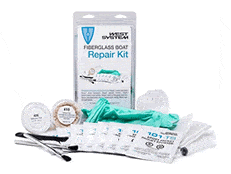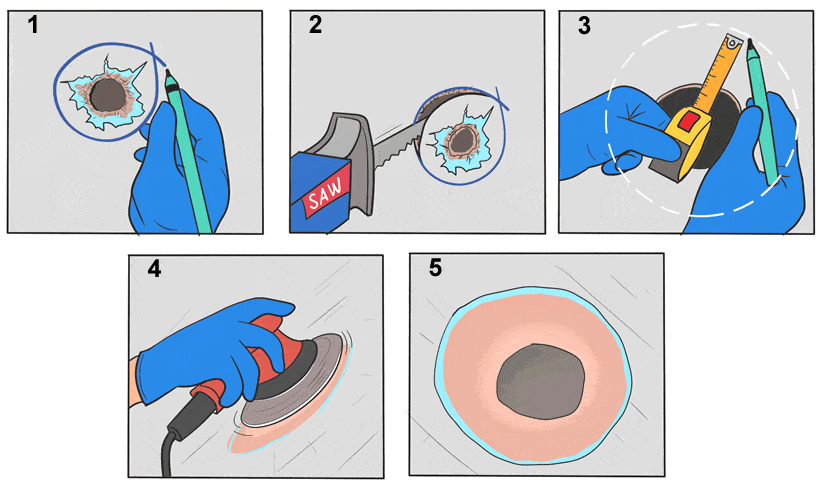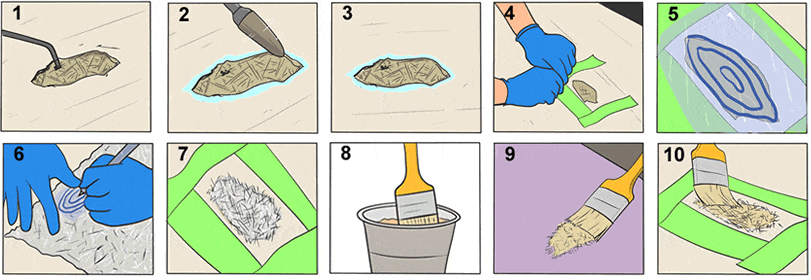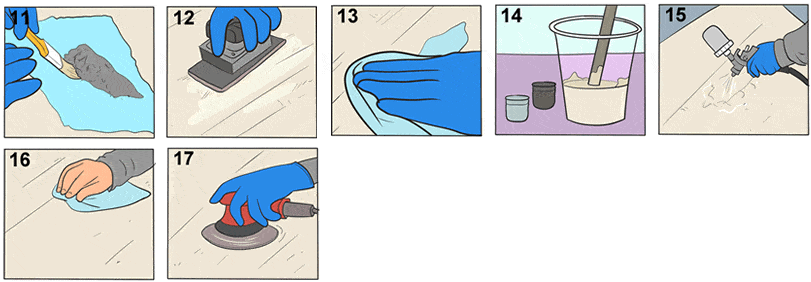How To Repair Small Fiberglass Holes
Naught can sink a gunkhole faster than a hole, and fifty-fifty the smallest hole could sink a send. This is hopefully not something every boat owner will demand to worry about, simply it is a good idea to know how to set a pigsty on a boat just in instance the unthinkable e'er happens to yous. If your boat springs a leak, you should take it out of the h2o right abroad and get it repaired earlier going back out.
This past summertime I was having java with a friend I hadn't seen since I was young, and I told him how I bought my first boat recently. He started to tell me a story that has been stuck in my head ever since he told it to me. He told me how a few summers agone his family rented a cottage with friends of his, and the cottage came with access to a boat down at the dock. One of the teenage boys in the group had taken the boat out and must have striking a stone or something, considering the next day when they all went back downwardly to the dock, there was well-nigh viii inches of water in the boat. When the owner showed up he took the boat out of the water and pointed out stretches and a crack in the lesser left side of the hull. Needless to say, that homo volition probably never include his boat for strangers to use again.
How Much Does Fiberglass Repair Price?
The cost to repair fiberglass and gelcoat volition vary depending on how much damage is done. Typically this cost could range from $75 to $125, per hour in most places. Again depending on how severe the damage is, this could take anywhere from a few hours, to several hours. For example, chips and gouges can take a few hours, while an bodily hole could take five to ten hours.
You can choose to repair the damage yourself, and in most cases, it's a fairly easy, straightforward procedure. If you accept all of the tools needed, you could probably set up the repair for about $xxx – $60 depending on how severe the damage is.
Fiberglass Boat Repair Kit
 If your fiberglass repair is not too large, you tin can get away with ownership a repair kit to fix the problem yourself. There is a fiberglass repair kit on Amazon chosen Westward System 105-K Fiberglass Gunkhole Repair Kit that is nifty for repairing cracks, scraps, gelcoat blisters, loose hardware, damaged keels and smaller holes under 1″ in bore. The package comes with everything y'all volition need to perform the repair, besides equally detailed instructions on how to use the production.
If your fiberglass repair is not too large, you tin can get away with ownership a repair kit to fix the problem yourself. There is a fiberglass repair kit on Amazon chosen Westward System 105-K Fiberglass Gunkhole Repair Kit that is nifty for repairing cracks, scraps, gelcoat blisters, loose hardware, damaged keels and smaller holes under 1″ in bore. The package comes with everything y'all volition need to perform the repair, besides equally detailed instructions on how to use the production.
Currently, Amazon is selling this repair kit for $34.26 as of the fourth dimension I am writing this. Click hither to check the current price.
What is Gelcoat For Boats?
The gelcoat on a boat is the outer surface layer on a fiberglass gunkhole hull, which is designed to protect the bottom layers of fiberglass, and give your boat that colour and smooth finish. The gelcoat is made upward of special polyester resin and fiberglass, or epoxy resin which is typically used with carbon fiber for extra force and h2o-resistance.
But similar whatever other end, gelcoat is prone to scratches, chips, and deterioration. You might notice that over time your gelcoat might start to show 'spider web' looking cracks which would indicate a weakness in the underlying fiberglass. Another trouble you might notice with the gelcoat is blistering, which mostly means that there is a water intrusion under the gelcoat itself.
Well-nigh of the time the repairs to gelcoat scratches, cracks, and fries are a pretty straightforward repair that tin can more often than not be fixed using a gelcoat paste. Information technology's an easy chore that tin can be performed by almost anyone, and actually only requires a repair kit. The trickiest part is the sanding and polishing that's required to blend the surface area with the hull.
How Do You Get Scratches Out of Gelcoat?
If your scratches are on the surface of the gelcoat, and then those can be buffed out using a polishing compound, but if the scratches are deep they'll need to exist filled in. Normally if the surrounding gelcoat is in good condition, you lot can use a gelcoat paste to fill in the scratches. Because the surface of the cured gelcoat paste will be uneven, you will need to sand and polish the repair area.
What you volition need:
Kickoff, you are going to need a gelcoat paste that tin be picked up in a repair kit for less than $35. The kit should come up with the gelcoat paste and hardener, selection of pigments, mixing sticks, and sealing film. You volition also demand to buy a single sheet of 150-, 220-, 400-, and 600-grit wet-or-dry sandpaper, and a flexible plastic spreader if you don't already have one.
Matching the colour:
Matching the colour is going to exist the toughest role of the repair. Many experts can tell y'all that information technology's very hard to perfectly match the color on a boat that's been in the sun for a few years. White is typically a picayune easier to endeavour matching, it'due south more different when y'all kickoff to go into colored hulls.
You can go a color-sample card from your local paint supply store that best matches your hull. In one case you lot know which colour-sample best matches, you can then ask the shop clerk for the colour formula used to create this specific color blend. With that information, you can then endeavor to recreate the same color combination using the tints that came in your repair kit.
Prepare the scratch:
Before yous get-go to apply the gelcoat paste to the scratch, accept a screwdriver and run information technology downward the scratch to open it upwards a little wider into a V shape. The reason for this is because the gelcoat paste is very thin and if it's applied over the scratch then it'll just terminate up forming a bridge over the scratch leaving a void nether the newly applied gelcoat paste.
Utilise Hardener:
To employ the hardener, make certain to read and follow the manufacturer's instructions. Typically every bit a general dominion, four drops of hardener will catalyze ane ounce of resin at 1 pct. Information technology's better to add too little than too much hardener. The mix shouldn't start to harden in less than 30 minutes. Hardening should take almost two hours.
Apply the gelcoat paste:
Using a flexible plastic spreader, begin to work the gelcoat paste into the scratch. While applying the gelcoat paste, keep in listen that polyester resin volition shrink slightly as it cures, and then you'll want to have the paste stick out a fiddling from inside the scratch. Remember you will be sanding this once it's cured and so it'll be okay to put a piffling extra on. Don't put too much actress, because that'll create actress work for you when sanding.
Embrace the repair area:
Gelcoat does not fully cure unless it'south covered up with a plastic sheet. Your repair kit might have come with a plastic moving picture that you'll have to utilise to embrace the repair area. If y'all didn't receive a plastic picture show with the repair kit, y'all can employ some Saran Wrap or a plastic sandwich bag. Outset start by taping one side downward to the surface only abreast the repair, and then smooth out the plastic onto the gelcoat and record downwards the remaining sides. Let the plastic sit for at least 24 hours.
Sanding and polishing:
Once you lot've waited over 24 hours, you can remove the tape and plastic. Using a sanding cake and a sheet of 150-grit sandpaper, begin to sand out the new section of gelcoat. For this, you'll desire to take your time and make sure you are just sanding the new patch of gelcoat and not the former surrounding gelcoat surfaces. Using a sanding block will help you lot keep the sanding bars to the repair area.
In one case the new gelcoat has been sanded downward and it's now flush, switch to 220-grit wet-or-dry sandpaper. Continue to wet sand the repair, keeping your sanding block flat the whole time. For this, you are going to have to continue a irksome drizzle of water running on the sanding area, while you sand the repair in a circular motility. Every so oftentimes, terminate sanding and accept your finger and run it over the repair area feeling for the ridge. Stop sanding when you lot tin can no longer feel a surrounding ridge.
Without using the sanding block anymore, switch over to a 400-grit wet-or-dry out newspaper. Brainstorm to sand the repair some more using water, until the repair area has a compatible advent. Switch to a 600-grit wet-or-dry out paper and continue sanding with water trickling over the repair for merely a little longer.
Dry out the h2o off using a soft fabric. Use a rubbing chemical compound to help requite the gelcoat a nice high gloss look. Employ the chemical compound over a soft cloth, and begin to vitrify it over the surface of the repair area with a circular motility, beginning past using heavy pressure, then gradually reducing the pressure until the surface becomes burnished looking. If y'all are nevertheless able to encounter swirl marks in the gelcoat, proceed to buff them out using a very fine finishing compound.
Finishing bear on:
In one case you have finished buffing out the last of the swirl marks in the gelcoat, you lot can now give the area a waxing. If you were able to match upwardly the color properly, then once you are finished, the repair area should exist hard to observe.
Repair small hole in a fiberglass boat hull
Hole going right through fiberglass into the boat:

- First, examine the hole and look for cracks and chips extending out from the pigsty. Use a marker to circle the unabridged damaged area. Making sure to include the croaky spots.
- Adjacent, take a saw and cut out the damaged area that y'all've circled with the marker.
- At present that the holes cut out, y'all demand to make up one's mind the thickness of the hull substrate and multiply that past 10. This will give you lot a circumference around the hole that you'll need to bevel downwards. Take a measuring tape and marker to outline that distance effectually the hole.
- Using a power sander with a 50 grit sanding disc, you can now bevel the whole edge out to your marking.
- In one case y'all've finished bevelling the area, y'all at present need to find something to get in behind the pigsty to block it. Some people use Ducktape for this or a piece of wood with plastic wrap over information technology.
You can now follow the steps below starting on #4 to patch up the hole.
Cracked couple layers of fiberglass, non quite through into the boat:


- Chip away any loose fiberglass from around the hole.
- Next, take a small grinder and smoothen the edges of the hole, every bit well equally the exposed fiberglass.
- After you've ground the area, y'all should now be down to the solid laminate.
- Using a painters tape, place the tape around the pigsty to avoid getting access resin on other parts of the hull.
- Accept a clear piece of plastic and place it over the hole. Now using a marker, trace around the edges of the hole. Next, come in a piddling from the border and trace the outline out again. Finally in one case again, within that outline, coming in a piddling more, trace around the hole i more time. You should have iii outlines of the pigsty, that will await like the rings on a tree stump.
- Adjacent, cut out the larger outline first, and than trace that onto the new canvas of fiberglass. Once yous've cut the fiberglass out, cut the adjacent size outline out of the plastic and trace that on the fiberglass. Do this until you have all three outlines of the fiberglass cut out.
- Stack the pieces in the void that y'all ground out on the hull (putting the smallest size down first and working up) and check if the meridian will be good, or if you need to add ane more layer. Near of the time you can become away with iii layers, but adding an additional layer wouldn't hurt. It would just mean extra sanding if it was too high.
- Next, mix up the vinyl ester resin and hardener in a small plastic container. Mix information technology upwardly really expert.
- Take a paintbrush and carefully wet each piece, front end, and back.
- Accept the pieces, one at a time and place them in the void. Start with the smallest size get-go and working up. Using your paintbrush, carefully spread them out getting rid of any air pockets or wrinkles caused by placing them downwards.
- After the last slice is added, remove the surrounding tape, so have some peel ply and place it over the repair. Using your paintbrush, carefully dab information technology around the peel ply and spread it out. Then let it sit for about an hr.
- After an hour, y'all can so take a sander and slowly sand the area smoothen.
- Once you've finished sanding the repair, clean the area with some acetone.
- This is where things get a little tricky. Mix upward a batch of gel coat, trying to match the existing hull color.
- Once you lot think yous have the same colour, it's fourth dimension to apply the paint to the repair spot. Using a spray nozzle is easiest.
- Once the gel coat is hardened, take some acetone and wipe the expanse make clean.
- Finally, perform some wet sanding to the surface area to help transition the repair to the rest of the hull and give it that natural look.
Source: https://boatingforbeginners.com/fix-a-hole-on-a-fiberglass-boat/
Posted by: millermagand.blogspot.com


0 Response to "How To Repair Small Fiberglass Holes"
Post a Comment